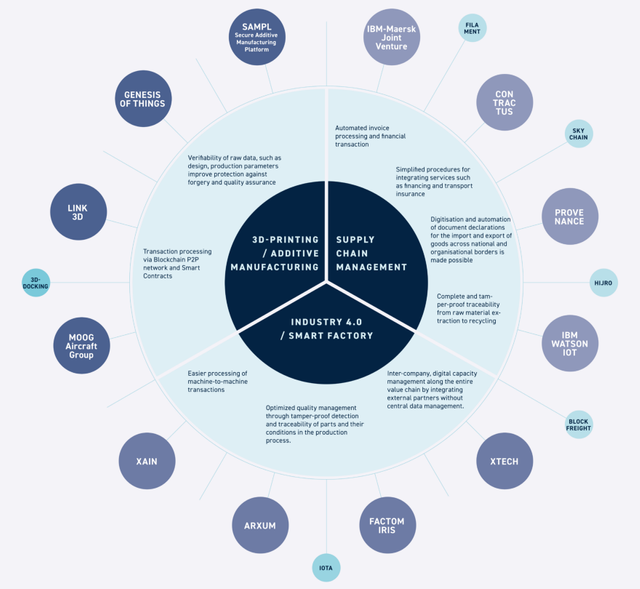Manufacturing and logistics in the age of blockchain
CERTAINTY 1: Blockchain will not be a footnote in the history of technology
In many fields, blockchain technology is still in its infancy. However, due to the degree of adoption blockchain has gotten within the financial sector thus far, one thing is certain: blockchain is here to stay. Particularly in supply chain management and production processes, blockchain offers advantages that need to be implemented in many of the systems. Especially when hedging transactions, blockchain has two advantages ensuring that it is attractive to the industry in the long term. Firstly, it prevents the falsification of information in IT systems; secondly, it ensures information transparency at all stations of the value stream. For example, if a machine is connected to the blockchain in production, it can document exact numbers produced and other process parameters for each product in a forgery-proof manner.
CERTAINTY 2: Smart Contracts coordinate the process steps in a supply chain
Machines can communicate the completion of a component to the customer or the next station in the supply chain. Instead of connecting several different ERP / IT systems with each other under high time and cost expenditures, all participants would only need to access one blockchain interface that contains all externally relevant order data. Smart Contracts, which work on the basis of protocols such as Ethereum, Æternity, EOS, NEO, Stellar or IOTA, carry out many actions automatically. For example, they issue shipping orders to logistics service providers when a certain number of items has been reached, so the collection and delivery of goods can be coordinated more precisely and reliably.
CERTAINTY 3: Autonomous objects carry an individual life cycle signature
Of course, Smart Contracts are not limited to machines, but could provide every physical object in the supply chain with a blockchain framework contract. It contains the most important information about the product and at the same time, automates all the process steps. Goods are thus transformed into "Distributed Autonomous Objects" (DAO). Through "function orders", DAO can also require suppliers to continuously update information such as measured values, quality control results, or the delivery status of products. For this purpose, only the so-called "hash values", or simple "fingerprints" of the data, are exchanged rather than the full data, which increases security. If permitted, not only suppliers and partners, but also end customers could use this signature to trace the complete "life cycle" of a product on a smartphone or computer.
CERTAINTY 4: The human interface remains a risk zone
This transparency significantly improves control and compliance with quality standards, compliance guidelines, and social governance standards. As soon as companies link corresponding obligations with forgery-proof blockchain technologies, they can no longer pay lip service to controlling quality and work standards. For example, audits of supplier conglomerates can thus be carried out faster, more spontaneously, and with clearer results if one really wants to use this knowledge. However, blockchain technology does not release people from any control and responsibility. Finally, you cannot distinguish whether the data entered is correct or manipulated. All interfaces between the blockchain and the "real" world, where people decide on the collection and transmission of information, thus remain risk zones for actual and complete transparency.
CERTAINTY 5: Blockchain oracles validate information
At the same time, blockchain is equipping companies with a new arsenal of methods to detect manipulation quickly. Since blockchains themselves do not access information outside their chain, they require a separate instance to check whether the conditions of the "smart contracts" have been met as agreed. One such instance is "blockchain oracles", which provide external information about the real world, such as payment transactions, price, or other changes in the blockchain. For example, if the stock exchange raw material prices reach a certain value, predefined algorithms in the smart contract can trigger price comparisons with suppliers. By using multiple sources of information, organizations can ensure the best possible validity of the information.
CERTAINTY 6: Batch size 1 is possible at mass production conditions
Bicycles with the perfect frame height, tailor-made shirts, or individually designed watches: Blockchain technology opens up realistic options for the consumer goods industry to produce very individual products at mass production costs. However, the prerequisite is continuous digitization of all process steps, from the collection of customer data, to the delivery of goods.
Find the entire magazine at :https://www.roi-international.com/fileadmin/user_upload/dialog/58/ROI_dialog_58_EN.pdf
